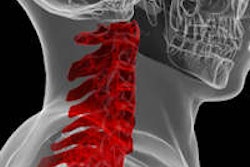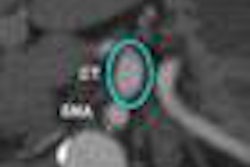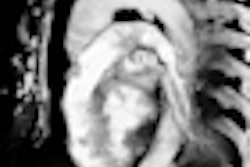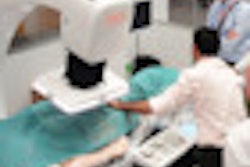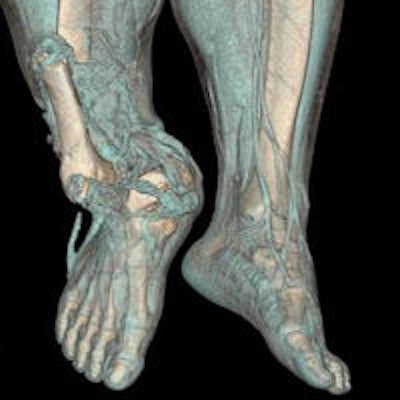
Emergency radiology is an increasingly important field, as shown by last weekend's event, "Fit for the Specialist: Emergency Without Crisis," held in Berlin. The following is an interview by the German Radiology Society (DRG) with Dr. Stefan Wirth, scientific director of the meeting and program planning officer of the European Society of Emergency Radiology (ESER).
German Radiology Society: How important is a multidisciplinary approach to this field?
Wirth: The answer is simple: It's crucial! Although there are very many diagnostic options within radiology, it is usually the other medical colleagues who carry out the appropriate treatment, even in emergency situations. The basic precondition here is efficient communication: In addition to the human level and interactions between colleagues, this includes information systems and the infrastructure.
 A simulation of a mass of people injured in a bus accident. Image courtesy of the DRG.
A simulation of a mass of people injured in a bus accident. Image courtesy of the DRG.What sets apart good emergency radiologists?
They use rapid and high-quality diagnostic tools to create the basis for rapid and good treatment. But speed is paramount here -- and it is essential. Medical colleagues usually place an especially high value on the radiologist's judgment in emergency situations. It is therefore crucially important to be able to make correct decisions very quickly, and to communicate these as swiftly as possible to the right places and also to take responsibility for them. This is particularly important for the care of the most severely injured, but is by no means limited to such cases.
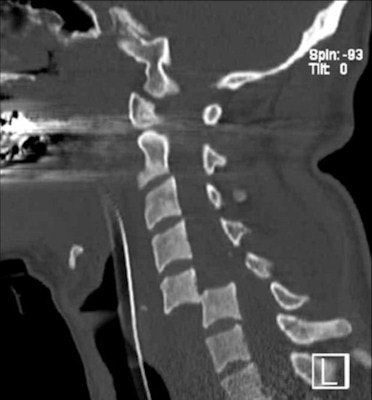 Dislocation injury to the cervical spine after road traffic accident with permanent high paraplegia. Image courtesy of Dr. Stefan Wirth.
Dislocation injury to the cervical spine after road traffic accident with permanent high paraplegia. Image courtesy of Dr. Stefan Wirth.What legal aspects are particularly important for emergency radiology?
 CT volumetric representation of a complex amputation injury of the right lower extremity due to trauma sustained from road traffic accident. Image courtesy of Dr. Stefan Wirth.
CT volumetric representation of a complex amputation injury of the right lower extremity due to trauma sustained from road traffic accident. Image courtesy of Dr. Stefan Wirth.
Most of the legal aspects arise from specific clusters of situations that occur in the course of everyday working life. Suddenly, some totally new questions crop up. How do I deal with pediatric patients who are emergency cases if I cannot contact their parents? Or what should I do if a medical colleague decides that something is an emergency but I cannot easily verify this? Such questions are immensely important in practice, but are difficult to teach.
Also, in everyday professional life, people do not necessarily have time to give such questions full consideration. However, it is absolutely necessary for emergency radiologists to know about quality assurance measures, the laws on patients' rights, the duty of giving information, and the duties relating to disclosure and judicial authorities; these topics must be addressed.
Why is the topic of emergency radiology so relevant to foundation training?
Its importance should become clear at the very latest by the first night on duty. Suddenly you are required to make your own decisions and are confronted directly with the high expectations of related specialist disciplines. This is why many radiologists embarking upon their foundation training often regard emergency radiology with awe (which is right) and sometimes with fear (which is wrong).
This "angst" probably has something to do with the fact that emergencies almost always form an essential part of the final examinations for specialist training. For this very reason, the benefits of early exposure to emergency radiology are just as important for doctors starting their foundation training as they are when their final specialist examination is imminent. Such early exposure will ensure, as far as possible, that worries or examination nerves are minimized. In fact, it is more likely to awaken interest in this highly important field.
How do you want emergency radiology to develop in Germany?
I should be delighted if we managed to dispel unnecessary anxieties and can promote the particular qualities of the emergency radiologist, so that acute care would improve even more. These are some of the reasons why this "Fit for the Specialist" event is an important step in the right direction.
 We need to dispel unnecessary anxieties over emergency radiology, Dr. Stefan Wirth said.
We need to dispel unnecessary anxieties over emergency radiology, Dr. Stefan Wirth said.
What was the main aim of the "Emergency Without Crisis" event?
Our chief aim for this event was to take the fear out of night duty and to show our younger colleagues how challenging and interesting this field is. In keeping with the "Fit for the Specialist" series of the German Radiology Society, this event also acted as a refresher for the emergency radiology part of the specialist examination. This was a one-day block session with expert speakers. It focused on the special features of emergency investigation records, management of the multiple trauma and resuscitation rooms, emergency intervention with overview of the material, complications in radiology, and legal matters. To round this off, there are important child-related aspects. At the end, the participants interactively evaluated the speakers, and the event as a whole; everybody made the most of this opportunity, so that the future events we offer can be of even higher quality.
Editor's note: This article is an edited version of a translation of an interview carried out in German and published online by the German Radiology Society (DRG, Deutsche Röntgengesellschaft e.V.). Translation by Syntacta Translation & Interpreting.




